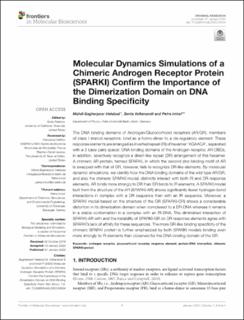| dc.contributor.author | Bagherpoor Helabad, Mahdi | |
| dc.contributor.author | Volkenandt, Senta | |
| dc.contributor.author | Imhof, Petra | |
| dc.date.accessioned | 2021-03-02T14:45:44Z | |
| dc.date.available | 2021-03-02T14:45:44Z | |
| dc.date.created | 2020-10-22T15:37:33Z | |
| dc.date.issued | 2020-01 | |
| dc.identifier.citation | Helabad, M.B., Volkenandt, S., Imhof, P. (2020) Molecular Dynamics Simulations of a Chimeric Androgen Receptor Protein (SPARKI) Confirm the Importance of the Dimerization Domain on DNA Binding Specificity. Frontiers in Molecular Biosciences, 7(4), 1-14. | en_US |
| dc.identifier.issn | 2296-889X | |
| dc.identifier.uri | https://hdl.handle.net/11250/2731224 | |
| dc.description.abstract | The DNA binding domains of Androgen/Glucocorticoid receptors (AR/GR), members of class I steroid receptors, bind as a homo-dimer to a cis-regulatory element. These response elements are arranged as inverted repeat (IR) of hexamer “AGAACA”, separated with a 3 base pairs spacer. DNA binding domains of the Androgen receptor, AR-DBDs, in addition, selectively recognize a direct-like repeat (DR) arrangement of this hexamer. A chimeric AR protein, termed SPARKI, in which the second zinc-binding motif of AR is swapped with that of GR, however, fails to recognize DR-like elements. By molecular dynamic simulations, we identify how the DNA binding domains of the wild type AR/GR, and also the chimeric SPARKI model, distinctly interact with both IR and DR response elements. AR binds more strongly to DR than GR binds to IR elements. A SPARKI model built from the structure of the AR (SPARKI-AR) shows significantly fewer hydrogen bond interactions in complex with a DR sequence than with an IR sequence. Moreover, a SPARKI model based on the structure of the GR (SPARKI-GR) shows a considerable distortion in its dimerization domain when complexed to a DR-DNA whereas it remains in a stable conformation in a complex with an IR-DNA. The diminished interaction of SPARKI-AR with and the instability of SPARKI-GR on DR response elements agree with SPARKI's lack of affinity for these sequences. The more GR-like binding specificity of the chimeric SPARKI protein is further emphasized by both SPARKI models binding even more strongly to IR elements than observed for the DNA binding domain of the GR. | en_US |
| dc.language.iso | eng | en_US |
| dc.publisher | Frontiers Media S.A | en_US |
| dc.rights | Navngivelse 4.0 Internasjonal | * |
| dc.rights.uri | http://creativecommons.org/licenses/by/4.0/deed.no | * |
| dc.title | Molecular Dynamics Simulations of a Chimeric Androgen Receptor Protein (SPARKI) Confirm the Importance of the Dimerization Domain on DNA Binding Specificity | en_US |
| dc.type | Peer reviewed | en_US |
| dc.type | Journal article | en_US |
| dc.description.version | publishedVersion | en_US |
| dc.subject.nsi | VDP::Matematikk og Naturvitenskap: 400::Basale biofag: 470 | en_US |
| dc.source.pagenumber | 1-14 | en_US |
| dc.source.volume | 7 | en_US |
| dc.source.journal | Frontiers in Molecular Biosciences | en_US |
| dc.source.issue | 4 | en_US |
| dc.identifier.doi | 10.3389/fmolb.2020.00004 | |
| dc.identifier.cristin | 1841575 | |
| cristin.ispublished | true | |
| cristin.fulltext | original | |
| cristin.qualitycode | 1 | |

